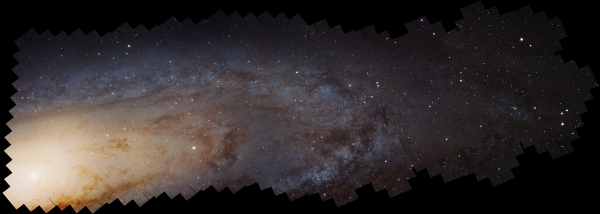
It’s Hubble’s 25th anniversary in space this year but it seems like we’re the ones getting all the presents! Yesterday NASA released two new high-def versions of the famous “Pillars of Creation” image, and now today there’s this: Hubble’s most detailed image ever of the Andromeda Galaxy!
Containing over 100 million stars it’s not just the best view yet of Andromeda – it’s also the most expansive image ever made with Hubble. Although the galaxy is 2.5 million light-years away it extends across an area larger than the full Moon in the sky, so to create such a detailed mosaic Hubble had to obtain 7,398 images taken over 411 individual pointings! It’s 1.5 billion pixels covering an area over 40,000 light-years across.
According to NASA, it’s “like photographing a beach and resolving individual grains of sand.” Wow!
Check out the full image below:
 From the NASA image release:
From the NASA image release:
This ambitious photographic cartography of the Andromeda galaxy represents a new benchmark for precision studies of large spiral galaxies that dominate the universe’s population of over 100 billion galaxies. Never before have astronomers been able to see individual stars inside an external spiral galaxy over such a large contiguous area. Most of the stars in the universe live inside such majestic star cities, and this is the first data that reveal populations of stars in context to their home galaxy.
The panorama is the product of the Panchromatic Hubble Andromeda Treasury (PHAT) program. Images were obtained from viewing the galaxy in near-ultraviolet, visible, and near-infrared wavelengths, using the Advanced Camera for Surveys and the Wide Field Camera 3 aboard Hubble. This view shows the galaxy in its natural visible-light color, as photographed with the Advanced Camera for Surveys in red and blue filters July 2010 through October 2013.
Click here for a super high-resolution version (195 mb).
For an idea of where in the entire M31 galaxy the images were taken, see below:

M31 is the nearest spiral galaxy to our own Milky Way, located about 2.5 million light-years away in the constellation Andromeda. Its bright central region can easily be seen on dark nights without a telescope as a fuzzy blur, although its outermost edges require some aid. As another entire “island universe” (to quote astronomer Heber Curtis) M31 is the most distant object visible with the naked eye.

Launched on April 24, 2000 during STS-31, 2015 is Hubble’s 25th year in orbit and I can only assume more amazing images from the Hubble team will keep coming!
Source: NASA/Hubble
Added Feb. 15, 2015: For a real mind-blowing experience, watch the HD video of this image zooming in on the stars of Andromeda (h/t to the Science & Story blog):
Reblogged this on 4t4m4t4 and commented:
Andromeda Galaxy
LikeLike